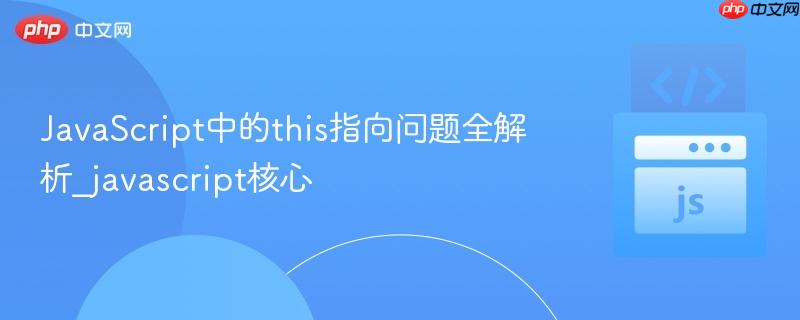this的指向在函数执行时确定,遵循“谁调用,this就指向谁”原则:全局环境中this指向window或global;普通函数调用时非严格模式下指向window,严格模式为undefined;对象方法调用时指向调用它的对象;构造函数中this指向新创建的实例;箭头函数无自身this,继承外层作用域;通过call、apply可立即指定this,bind可永久绑定this;事件处理中普通函数this指向绑定元素,箭头函数则继承外层。

在JavaScript中,this 是一个非常核心又容易让人困惑的概念。它的指向不是在定义时确定的,而是在函数执行时动态绑定的。理解 this 的指向机制,对掌握 JavaScript 面向对象编程、事件处理、回调函数等至关重要。
在全局环境中(即不在任何函数内部),this 指向全局对象。在浏览器中,全局对象是 window;在 Node.js 中,是 global。
例如:console.log(this === window); // true(浏览器环境)
无论是否使用严格模式,全局 this 都指向全局对象。
函数内部的 this 取决于函数是如何被调用的,而不是如何定义的。有以下几种常见情况:
立即学习“Java免费学习笔记(深入)”;
普通函数调用
在非严格模式下,this 指向全局对象(window);在严格模式下('use strict'),this 为 undefined。
function fn() {
console.log(this);
}
fn(); // 浏览器中输出 window,严格模式下为 undefined对象方法调用
当函数作为对象的方法被调用时,this 指向该对象。
const obj = {
name: 'Alice',
greet() {
console.log(this.name);
}
};
obj.greet(); // 输出 'Alice'注意:this 只认最后调用它的对象。例如:
const person = { name: 'Bob' };
person.fn = obj.greet;
person.fn(); // 输出 'Bob'当使用 new 关键字调用函数时,this 指向新创建的实例对象。
function Person(name) {
this.name = name;
}
const p = new Person('Charlie');
console.log(p.name); // 输出 'Charlie'构造函数的执行流程包括:创建空对象、绑定 this 到该对象、执行函数体、返回新对象(除非显式返回其他对象)。
箭头函数没有自己的 this,它会继承外层作用域的 this 值。这是与普通函数最大的区别。
const obj = {
name: 'Diana',
normalFn: function() {
console.log(this.name); // 正常输出 'Diana'
},
arrowFn: () => {
console.log(this.name); // 输出 undefined(继承的是全局的 this)
}
};
obj.normalFn(); // 'Diana'
obj.arrowFn(); // undefined(因为外层是全局,this.name 为 undefined)箭头函数适合用于避免 this 指向丢失的场景,比如在 setTimeout 或数组方法中。
JavaScript 提供了 call、apply 和 bind 方法来手动控制 this 的指向。
call 和 apply
立即调用函数,并指定 this 值。区别在于参数传递方式:call 接收多个参数,apply 接收参数数组。
function introduce(age, city) {
console.log(`I'm ${this.name}, ${age} years old, from ${city}`);
}
const user = { name: 'Eve' };
introduce.call(user, 25, 'Beijing'); // 使用 call
introduce.apply(user, [25, 'Shanghai']); // 使用 applybind
bind 返回一个新函数,其 this 被永久绑定到指定对象,不会被后续调用方式改变。
const boundFn = introduce.bind(user, 30);
boundFn('Guangzhou'); // I'm Eve, 30 years old, from Guangzhoubind 常用于事件监听或异步回调中保持 this 指向。
DOM 事件处理函数中的 this 默认指向绑定事件的 DOM 元素。
button.addEventListener('click', function() {
console.log(this); // this 指向 button 元素
});如果使用箭头函数,则 this 继承外层作用域,可能不再是 DOM 元素。
若在对象方法中添加事件监听,需注意 this 丢失问题:
const handler = {
message: 'Clicked!',
onClick: function() {
console.log(this.message);
}
};
// 错误:this 不再指向 handler
button.addEventListener('click', handler.onClick); // 输出 undefined
// 正确做法:使用 bind
button.addEventListener('click', handler.onClick.bind(handler));基本上就这些。this 的指向看似复杂,但只要记住“谁调用,this 就指向谁”这一核心原则,再结合调用方式和特殊规则(如箭头函数、new、bind),就能准确判断。多练习实际场景,this 就不再是个难题。
以上就是JavaScript中的this指向问题全解析_javascript核心的详细内容,更多请关注php中文网其它相关文章!

java怎么学习?java怎么入门?java在哪学?java怎么学才快?不用担心,这里为大家提供了java速学教程(入门到精通),有需要的小伙伴保存下载就能学习啦!




Copyright 2014-2025 https://www.php.cn/ All Rights Reserved | php.cn | 湘ICP备2023035733号